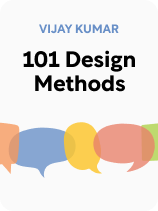

This article is an excerpt from the Shortform book guide to "101 Design Methods" by Vijay Kumar. Shortform has the world's best summaries and analyses of books you should be reading.
Like this article? Sign up for a free trial here.
What is Vijay Kumar’s 7-step innovation process? How do these seven steps lead you to the big picture?
In 101 Design Methods, Vijay Kumar describes seven steps you must take if you want to keep churning out innovative products. From brainstorming to implementing the solution, the process is a recipe for success.
Continue reading for more information about the seven steps that will keep your business in innovation mode.
The 7 Steps That Make Up Innovation
Kumar’s approach to managing innovation consists of breaking down the 7 Steps of Innovation process to help you plan, schedule, and manage innovation.
The seven steps that Kumar identifies follow a logical progression, but sometimes you have to revisit earlier steps later in the project or cycle through multiple iterations of the whole sequence.
Step 1: Develop a Clear Idea of What You Intend to Accomplish
Kumar writes that you start by developing a clear understanding of big-picture trends in your industry, adjacent sectors, culture, regulatory environment, and so forth. To do so, ask the following questions: What are your goals for this innovation project? What problem do you want to solve or what value do you aim to create? Who is your target customer? What constraints and risks do you have to work with? These questions will help you research trends so that you can identify areas of opportunity and make an informed decision about the direction to take the project.
Step 2: Define Your Operating Environment
Step 1 provided you with a clear view of the big picture, from which you selected an area to pursue innovation. Now in Step 2, you’ll narrow your focus and conduct more detailed research to fully understand the area that you’re focusing on.
Kumar recommends creating a detailed research plan. To make this plan, first identify what information you need. This might be answers to questions about your chosen area, like: What are your current capabilities in this area? What are your competitors’ capabilities? What legal regulations and cultural issues do you need to take into consideration when operating in this sector? Are there emerging technologies that could affect this area?
Then consider how you can get that information. Will you need to do market research? Legal research? Other research? Of course, you have limited resources, so you should note your time and budget constraints in your research plan. Then decide what research you’ll do to get the information you need within your time and budget.
Step 3: Understand Your Stakeholders
Not only do you need a detailed understanding of the situation (step 2), but you also need a detailed understanding of the people who will use your product or service. This is the focus of step 3. What do your users value? What are their priorities? What are their pain points (persistent problems) with the products they’re currently using? How much are they willing and able to pay for a solution to those pain points?
Kumar recommends conducting surveys and interviews to receive feedback. This helps you validate assumptions and gain a better understanding of your stakeholders and customers. In some situations, he recommends integrating certain stakeholders directly into your team as a way to get to know them and ensure their interests are represented throughout the project. Kumar also discusses techniques for conducting workshops and field visits. In addition to engaging users, Kumar recommends engaging with people who don’t use relevant products or services to find out what problems are keeping them away.
Step 4: Develop a Mental Model
Step 4 consists of analyzing and distilling all the data you collected in steps 2 and 3 to make sense of it. Based on your research findings, what are the most significant trends in your industry? Can you explain these trends with natural laws or other broadly applicable principles?
Similarly, can you describe a few archetypal users who represent all the different users and use cases that you studied? Also, consider other stakeholders such as regulatory officials and your own executives. Can you describe their respective interests well enough to predict how they’ll react to your ideas? Of all the insights you uncovered, which were the most unexpected? Kumar notes that your best opportunities for innovation often come from surprising, non-obvious findings.
(Shortform note: Making sense of large amounts of information can be challenging. In The Great Mental Models, Shane Parrish and Rhiannon Beaubien discuss mental tools and principles that you can use to cut through complexities and figure out what’s really going on. For example, they discuss principles like Occam’s Razor (accept the simplest explanation that fits the data) and Hanlon’s Razor (when examining people’s motives, look for the explanation that requires the least effort, such as presuming someone acted carelessly rather than maliciously).)
Step 5: Brainstorm Solution Elements
Now that you’ve sorted your data, imagine as many individual solutions as possible to fulfill unmet needs, eliminate pain points, or take advantage of opportunities to create value that you’ve identified in other steps. Kumar emphasizes that during this step, your team members should focus on coming up with new ideas and building on each other’s ideas, not on evaluating or criticizing ideas. You should also try to identify and reexamine assumptions about your field—don’t let industry conventions and traditional approaches constrain your thinking.
Step 6: Assemble and Evaluate Comprehensive Solutions
In step 6, you’ll take all the solution elements that you came up with in step 5 and piece them together in different combinations to create as many different complete solutions—products or services that meet the user’s needs—as possible. You’ll also evaluate these solutions to determine which ones would provide the most value to the user, the company, and any other relevant stakeholders. To do so, you might set up simulations or build prototypes so you can evaluate how well your solutions would work and what unique value or advantages they would provide.
Step 7: Plan to Implement the Solution
In step 6, you tentatively identified the best complete solution. Now in step 7, you’ll prepare detailed budgets, schedules, business plans, and marketing plans to implement the solution. This enables you to validate that your solution is actually practical to implement. It also makes the solution easier to communicate, which is important because you need all your stakeholders on board to move forward with implementation. You may need to build and test prototypes of your solution as part of step 7 to demonstrate the practical viability and value of your solution.

———End of Preview———
Like what you just read? Read the rest of the world's best book summary and analysis of Vijay Kumar's "101 Design Methods" at Shortform.
Here's what you'll find in our full 101 Design Methods summary:
- Why many companies don’t understand how to manage innovation
- A systematic approach to innovation management
- Specific tools and techniques you can use on innovation projects






